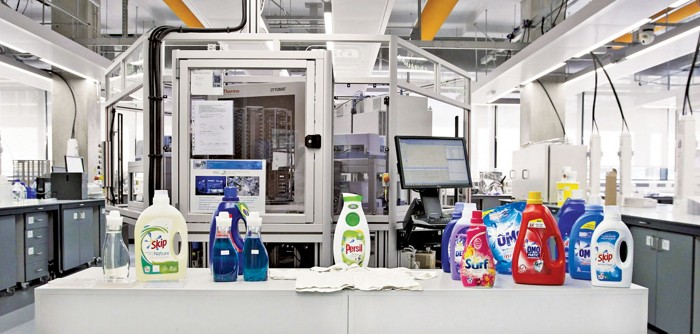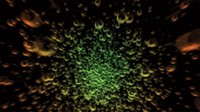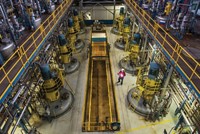Advertisement
Grab your lab coat. Let's get started
Welcome!
Welcome!
Create an account below to get 6 C&EN articles per month, receive newsletters and more - all free.
It seems this is your first time logging in online. Please enter the following information to continue.
As an ACS member you automatically get access to this site. All we need is few more details to create your reading experience.
Not you? Sign in with a different account.
Not you? Sign in with a different account.
ERROR 1
ERROR 1
ERROR 2
ERROR 2
ERROR 2
ERROR 2
ERROR 2
Password and Confirm password must match.
If you have an ACS member number, please enter it here so we can link this account to your membership. (optional)
ERROR 2
ACS values your privacy. By submitting your information, you are gaining access to C&EN and subscribing to our weekly newsletter. We use the information you provide to make your reading experience better, and we will never sell your data to third party members.
Consumer Products
Cutting the carbon out of cleaning at Unilever
The consumer goods firm wants its cleaning products to be carbon neutral by 2030. This is how it might get there
by Craig Bettenhausen
January 10, 2021
| A version of this story appeared in
Volume 99, Issue 2

Cleaning product makers have been chipping away at their carbon footprints for years by trimming packaging, increasing biobased ingredient content, and lowering recommended temperatures for product use. Unilever is now upping the ante.
The consumer goods giant announced in September that it will switch to 100% renewable or recycled carbon in its cleaning products by 2030—up from just 16% today. Unilever says the move will cut the carbon footprint of its cleaners by 20%. It’s part of an overall corporate goal of having net negative carbon emissions by 2030.
Unilever says it has set aside more than $1.2 billion to retool its product line around these goals. “That’s a big move. That’s an industry-leading move,” says Chris Sayner, vice president for sustainability at Croda, which makes surfactants and other ingredients for home and personal care products. “When somebody does something bold like this, there’s a wave that follows. That’s how the industry changes.”
But eliminating nonrenewable, fossil-derived carbon from cleaning products will be no small task. The surfactants that dominate laundry and dish detergent formulations are effective, and roughly half the surfactant volume on the market is derived from petroleum. Some consumers are willing to pay a premium for detergents with plausible sustainability claims, but few will tolerate inferior performance.
Meeting the carbon goal will thus require Unilever and its ingredient suppliers to adopt a multipronged approach that includes an increased role for enzymes, the introduction of live microbes in home cleaning, and an improved supply chain for biobased ingredients.
The first enzymes to make their way into consumer detergents were proteases meant to chew up blood and grass stains on clothes, according to David Joiner, head of household care North America at the industrial biotechnology company Novozymes. Once enzymes break down proteins, surfactants can more easily carry them away with the wash water.
“Using enzymes in cleaning products is not a new concept,” says Neil Parry, Unilever’s R&D program director for biotechnology and biosourcing. “However, we’ve only scratched the surface of what’s possible. The world has developed less than 5% of enzyme diversity for commercial opportunities.”
Novozymes and other firms are tapping into that biodiversity to make laundry and dish soap more efficient. Tide, Arm & Hammer, Seventh Generation, and other detergent brands already use mannanase and amylase enzymes, for example, to attack gums and starches. And more are on their way. “If you spill some salsa on your shirt, we have enzymes that directly attack that salsa,” Joiner says.
All that molecule snipping helps surfactants do their cleaning job faster, with less water, at pHs closer to neutral, and at lower temperatures. And less surfactant is needed. Joiner says that 1–3% enzyme in a formulation can replace 15% of the surfactant—handy, because surfactants are where most of the fossil-derived carbon comes in.
While enzymes are helping laundry and dish detergents perform better, live microbes are beginning to play a similar role in hard- and soft-surface cleaners.
Such probiotic cleaners aren’t totally new either. Institutional and industrial cleaners have used them for years in applications such as floors and grease traps. But they’re becoming more effective and easier to produce, says Nicholas Georges, vice president of scientific and international affairs at the Household and Commercial Products Association (HCPA), a trade group. As a result, they are making their way to cleaning product aisles in grocery stores.
Live microbes reduce the need for conventional surfactants in two ways. First, they excrete their own enzymes and biosurfactants, which they use to ingest oils and other grime. And of course they eat the things they’re meant to clean. Because a certain number of microbes remain on the surface after use, they make their way into the microscopic nooks and crannies that often escape a normal wiping down.
The result, microbe proponents say, is a deeper clean—as long as you accept the premise that a carpet or kitchen counter colonized by intentional bacteria counts as clean.
The timing is good for probiotics to come onto the scene. They are most effective with regular use, Georges says, and the pandemic has people cleaning more regularly.
Enzymes at work
Nature has an enzyme for just about everything, and researchers are bringing that biochemical diversity to bear in laundry, dishwashing, and other cleaning products. The result can be fewer petroleum-based ingredients.
Amylases
Starch, a long sugar polymer, acts as glue for dirt particles. Amylases cut starch molecules into soluble sugars or shorter, washable polysaccharides.
Cellulases
By eating away at fuzzed and frayed cotton strands, cellulases brighten and refresh fabric. They also remove cotton structures that can grab dirt back out of the wash, reducing the need for antiredeposition ingredients made from synthetic polymers.
LicheninasesCereal fibers contain a sticky carbohydrate known as β-glucan, which spreads over clothes in the wash and gives them a gray appearance. Licheninases can remove that layer.
Lipases
Lipase enzymes attack stains containing fats and oils by cutting triglyceride molecules into water-soluble glycerin and fatty acids.
Mannanases
Guar, xanthan, and locust bean gums are polysaccharides that thicken and emulsify a wide range of foods. Mannanases break bonds in the gums’ mannose units, which results in smaller saccharides that surfactants can grab more easily.
Pectate lyases
Pectate lyases attack stains containing pectin, a polysaccharide found in fruits and vegetables. The outcome is smaller sugar molecules that dissolve more easily.
Phosphodiesterases
Body odor is caused by stinky compounds excreted by bacteria after they eat biomolecules in sweat. Phosphodiesterase enzymes remove smell and discoloration by attacking the adhesives that microbes use to stick to surfaces.
Proteases
Protease enzymes break down protein molecules—such as in meat, grass, milk, and blood stains—so surfactants can lift them from clothes and dishes.
Sources: Novozymes, C&EN research.
In 2019, the start-up Counter Culture Clean launched a line of probiotic cleaners containing a cocktail of beneficial microbes that make biosurfactants. Last September, Novozymes launched Microvia, an ingredient based on live Bacillus bacteria meant for hard-surface cleaners. Joiner says the firm is also working on biological ingredients for other home care categories like bathrooms, toilets, and soft surfaces.
Using live microbes isn’t as simple as adding them to an existing product. Careful formulation is needed to deliver microorganisms to the end user. It’s an approach likely to be followed by both the very biggest players and some of the smallest.
Big corporations such as Unilever, Clorox, and Procter & Gamble have the resources to do the R&D legwork and can launch a product without betting the whole company. On the other hand, start-ups can turn an innovation into a product more quickly. Georges says the first cleaners in this category will come from companies at those two ends of the size spectrum. If consumers adopt them, the rest of the industry will follow.
At some point, though, most cleaners need surfactants. When it comes to eliminating fossil carbon, Unilever’s Parry says, “our biggest challenge in terms of volume is surfactants.”
Chemical firms such as Croda, Stepan, and Clariant make surfactants from both fossil fuel and plant oils. In both cases, the goal is a molecule with a hydrophilic head and a long hydrophobic tail to helpdirt and grease mix with water. Petroleum hydrocarbons are oxidized into fatty alcohols and carboxylic acids; natural oils are esterified or saponified into fatty alcohols or acids. Both types often undergo further chemical modification, such as ethoxylation and sulfation, to dial in properties like foaminess and cleansing power.
Among plant feedstocks, palm oil dominates. And that seems fine at first glance. Palm oil is rich in C16 and C18 fatty acids, which are good lengths to make detergents. And the oil palm tree produces 10 times as much oil per hectare of land as oil crops like canola. More than 60 million metric tons (t) of palm oil is produced globally each year.
The problem is, that last number has increased 10 times over since 1980, according to the Roundtable on Sustainable Palm Oil (RSPO), a nonprofit that promotes environmentally sound palm agriculture practices through education and product certification. Around the equator, where the oil palm tree grows well, landholders have cut down tropical rain forests to make room for more plantations, undermining the climate rationale for shifting from petroleum to palm.
A number of firms are working on biotechnology alternatives to palm. C16 Biosciences is fermenting a direct palm oil replacement; Locus Performance Ingredients, Evonik Industries, Stepan, Clariant, and others are working on biosurfactants, such as sophorolipids, rhamnolipids, and glucamides, that can be fermented from renewable feedstocks other than palm oil.
Unilever already has a dish soap in stores in Chile that uses rhamnolipids from Evonik, and the HCPA’s Georges expects biotech solutions to grow in popularity over the next few years.
Croda’s Sayner says the home and personal care product industry’s best bet for reducing its carbon footprint, however, is sustainable palm oil made without destroying rain forests. And he says the industry punches above its weight on that front. Croda has 14 plants that process palm oil or its derivatives, and all are certified by the RSPO, he says. P&G, Henkel, Unilever, and other major brands have committed to purchasing only sustainably produced palm oil and palm oil derivatives.
It’s not a perfect solution. Only 19% of the global palm oil supply is RSPO certified. And the RSPO itself faces criticism from Greenpeace and other groups that its standards and enforcement are vague and toothless and that its lower-tier certifications allow conventional oil to mix with certified sustainable oil.
The home and personal care product industry consumes about 5% of the world’s palm oil, Sayner says. The majority of the RSPO-certified palm oil derivatives used by the industry are mass-balance certified. In mass balance, a transesterification plant might process 70 t of sustainable oil along with 30 t of conventional oil. It could then sell 70% of the resulting fatty alcohol and glycerine as RSPO mass-balance certified.
Unilever says it’s pushing toward stricter standards in which sustainable palm oil would be physically separated throughout the supply chain. For example, it is collaborating with a US geospatial analytics firm to use traffic patterns to identify which plantations supply the companies it buys from.
Although not everyone agrees, Sayner says high standards from cleaning product makers and their suppliers have helped create a robust market and tracing system for sustainable palm oil. “I think the home and personal care industry can be very proud of its achievements. It’s still got work to do, but it’s effecting positive change,” he says.
Unilever executives know they must look beyond enzymes, microbes, and biobased surfactants in their carbon-reduction quest. The firm has started making powdered laundry detergent using soda ash produced in India with carbon dioxide captured from a nearby power plant.
It is also exploring ways to turn waste plastic into surfactants and ensure that polymers in its products, such as those used to prevent stain redeposition, are biodegradable. The company has set up an additional $1.2 billion fund for reforestation, wildlife protection, and water preservation projects.
Still, Unilever acknowledges that it has a long way to go. “The hardest ingredients are those where the supply chain is 100% dependent on fossil fuels,” Parry says. “Some ingredients don’t currently have another option.”





Join the conversation
Contact the reporter
Submit a Letter to the Editor for publication
Engage with us on Twitter